Cajon: description and device of the instrument

Cajon is an unusual musical instrument originally from Peru. The history of origin, device, types, as well as how to choose it and play correctly, is described within the framework of this article.
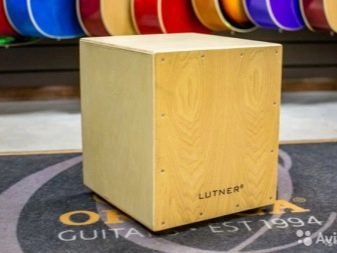

Origin story
There is no consensus about the time of origin of the instrument and the history of its origin. The official version says that the cajon appeared in the first half of the 19th century, while the unofficial version says two centuries earlier.
According to the emergence of the instrument, there is a point of view that the "culprits" of the appearance were slaves from South America. They were strictly forbidden to play traditional drums. Resourceful Africans were not taken aback and instead used boxes of fish, boxes of tobacco and cigarettes, which, respectively, have a low, medium and high sound.
Another version says that some kind of cajon was still in Central and West Africa. And together with the slaves, he arrived in Latin America. Because of its simplicity, it quickly became popular in colonial America. And since at that time the Spanish language was firmly rooted, the name of the instrument was given in Spanish.
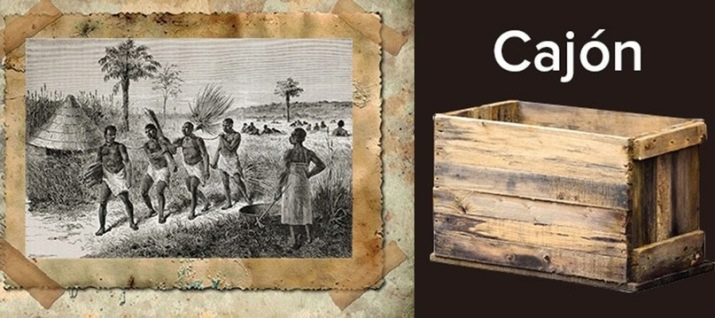
What it is?
The name of the musical instrument "cajon" in translation from Spanish means "box". Outwardly, it looks like an ordinary wooden, unremarkable box. Currently, various metals are used to create tools, not just wood. Cajon refers to drums, although it is not a drum in the usual sense. Its main advantage is practicality.
The overall design of the tool is simple. One side of the case is made of lighter material and the other five are made of stronger raw materials. As a rule, wood or plywood is used.
The most popular types of wood are beech, yew, ash, maple. Rare breeds - zebrano, bubing. The presence of individual parts, such as pedals, springs, etc., depends on the type of instrument.
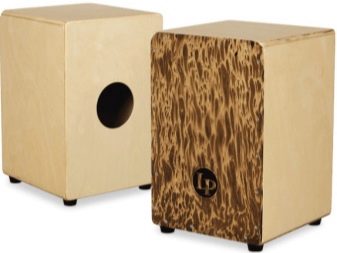
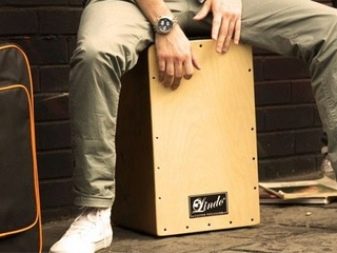
There are two main varieties: strings and small cajons. The former are equipped with 2–5 guitar strings fixed from the inside on the back wall of the structure (once these were guitar strings located at the corners, but now a standard snare is often found). Small ones have 4 mesh wires instead of strings. Small cajons emit crackling sounds during play, which is why they are used when playing with electric instruments.
The classic dimensions of the instrument (cm) are 50x30 (width and length), but usually this instrument is made depending on the height of the musician.
There is also the Afro-Peruvian type without strings and without wires. It emits the purest woody sound, for which flamenco performers appreciate it.
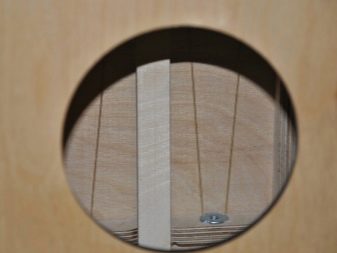

Views
If at first there was one simple design, then from the time the instrument was domesticated, they began to add different elements. As a result, several types have been created.
- The string cajon mentioned above.
- Without strings - the simplest model that has become widespread. It is most commonly used to create flamenco music.
- Dismountable is a practical option as it can be disassembled and reassembled if necessary in just a few minutes. This is especially important if you have to frequently move and transport the cajon. It is so compact that it can be easily disassembled in a case or bag.
- Bass is a non-standard model. The special sound and slightly different dimensions make the cajon special.
- Octacachons, Kongacachons and others. These are already variations of a different shape (hexagons and octagons). In such variations, the tapa is placed horizontally, so the manner of performance is different and resembles playing the congas.
- There are instruments with a complicated design, when the sound when hitting the left and right edges is significantly different, with a different shape.
- Among the modern instruments are electronic cajons.
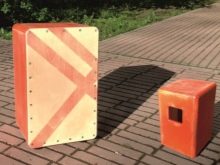
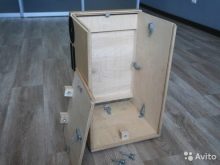

Criterias of choice
Having decided to purchase an exotic musical instrument, you should ask yourself the main question about the purpose of the acquisition (for amateur or professional play), about the frequency of use. All this will determine the type of cajon, the material of manufacture, and the price.
Material
The main requirement for the material is strength. The stronger, the longer the life of the instrument, because the musician sits on the cajon. Here it is also worth taking into account the body weight of the player himself.
Instruments made from different types of material sound differently, including from different types of wood. For example, fiberglass cajons sound very loud. This may not work for every performer.
When choosing, it is worth checking how each of the instruments sounds and trusting your own hearing.

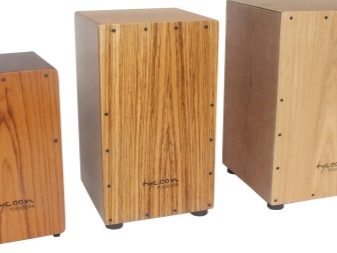
A cabinet made of sturdy plywood is the most common option. Such a model is inexpensive, but durable. It is simply impossible to damage or deform it. But wooden cajons have a higher cost. The more valuable the wood species from which the cajon is made, the higher the price.
The material from which the tapa is made is also of great importance. It can be plastic or plywood, or solid wood.
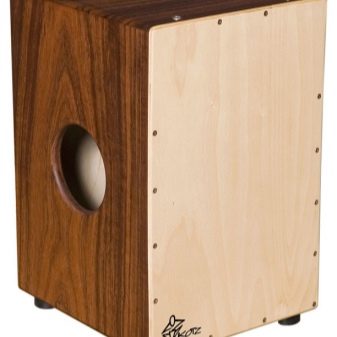
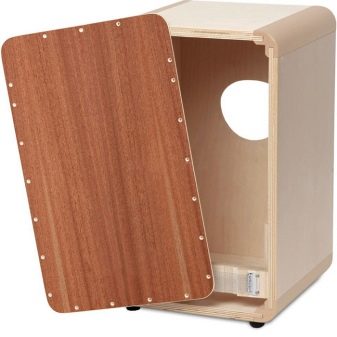
There is no need to save money here - you can choose a model with tapas made of high quality wood. Pure sounding in this case is ensured.
The "insides" of the instrument
Some musicians cannot do without sound amplifiers, microphones and other accessories, while others do not recognize any artificial complements.
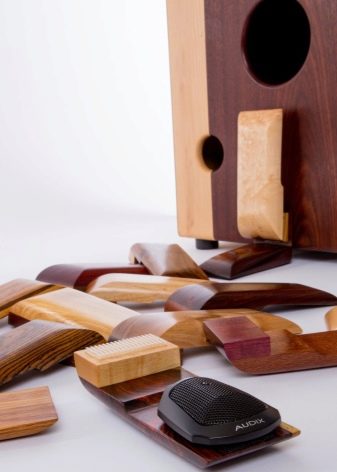
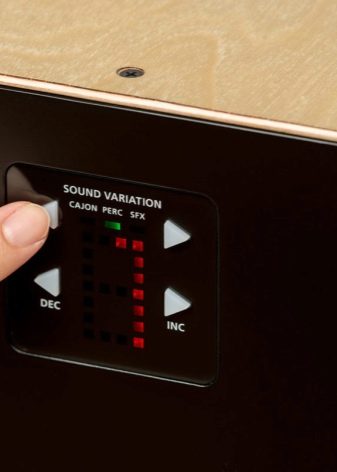
Price
Amateurs and simply keen cajons should start familiarizing themselves with the instrument on an inexpensive copy. It is also important to understand that a budget instrument is not necessarily of poor quality or bad. It is worth looking here, because among inexpensive models there are very worthy options with excellent sound (no worse than more expensive analogs). The main difference, as a rule, consists in the presence of additional elements in the latter. The brand of the musical instrument is also important.
For those who are engaged professionally or have serious intentions and long-term plans, you should not spare money to purchase a more expensive tool.
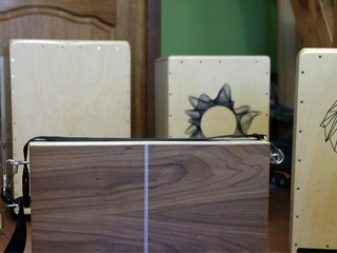
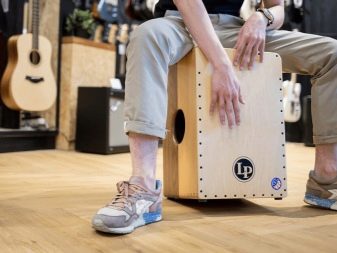
It is important to take into account all the details and be meticulous in choosing: the tool must fully meet all the requirements. These models often have audio amplifiers, which increases the range of applications.
Accessories
There are a lot of accessories for cajons. There are special bags for transportation, and cases, and pedals for compositions with percussion settings, and microphones and sticks for achieving a deeper sound, and additional reduced-size models that can be attached to the body of the main instrument.

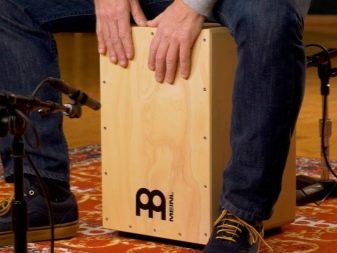
How to play?
Playing the cajon is an exciting experience. It seems that there is nothing difficult in this, why take any lessons. However, it has its own rules, features, subtleties. Therefore, if you want to master the instrument, you should undergo training from a professional musician.
There are several game techniques for producing sounds of different heights.
- To extract high-frequency sound, it is necessary to strike with your fingers on the upper part of the front edge.
- To get the bass, you need to hit with the whole palm slightly lower than in the first case. Alternatively, you can use a bounce or pinch hit.
- Striking the corners with your fingers produces a “click” sound.
Attention! You should not hit the center of the case, because the tapa vibration is muffled.

Conclusion
Cajon is an exotic instrument originally from Peru with an interesting history of origin. Despite the simplicity of construction, it sounds great and varied. Refers to percussion instruments. However, you cannot call it a drum in the literal sense of the word. The sound depends mainly on the material of manufacture, type of construction.
When choosing a tool, you must first determine the purpose of the acquisition. For amateurs, the budget version will be quite worthy, and professionals should consider models more expensive from well-known manufacturers. If necessary, you can purchase additional accessories in the form of sound amplifiers, a microphone and others. A carrying case is required.

You can master the basics of playing the cajon on your own through video tutorials on the Internet or on thematic sites. But to become a virtuoso, a more thorough study and immersion in the topic is required.
For how the cajon sounds, see the next video.








